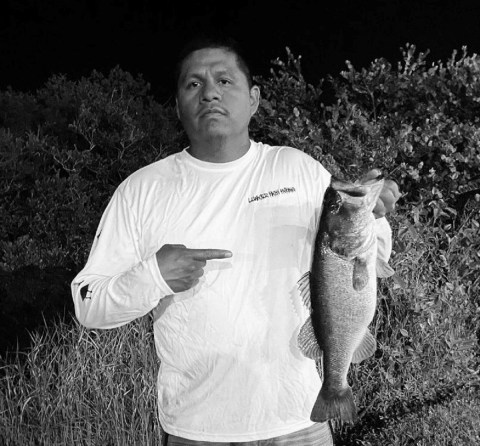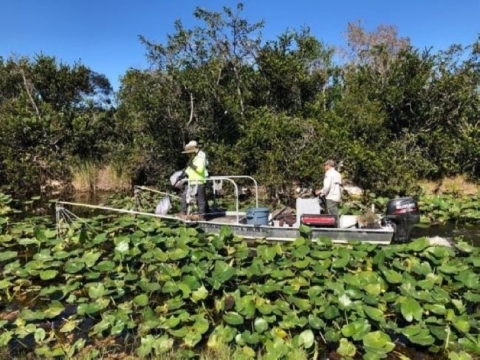Whenever he gets the chance, Glen Tiger heads for his favorite fishing hole … if you can call it that.
Perhaps it’s better to say that Tiger visits a 3-mile-long site that’s proof to what conservation can accomplish: the Old Tamiami Canal. Stocked with largemouth bass, bluegill, bowfin and other species native to South Florida fresh water, the canal allows Tiger and other members of Florida’s Miccosukee Tribe to put food on the plate.
Tiger’s catch represents a partnership between the Native American tribe and the U.S. Fish and Wildlife Service (Service), which answered the federally recognized tribe’s call when the Miccosukee started looking for native species free of non-accumulated mercury to replenish the waterway.
Tiger, the father of five, understands. He’s fishing for dinner, sure, but also helping keep alive a tradition as old as the tribe itself. The Miccosukee have always been anglers.
“One of our necessities is fish,” said Tiger, who likes to fry largemouth bass in a skillet. “With [the canal] we still practice it.”
The canal is a reminder that the Tribe and Service have shared goals, said Craig van der Heiden, director of the Miccosukee Fish and Wildlife Department.
In 2018, he was attending a tribal council meeting when the council’s chair, Billy Cypress, asked van der Heiden to undertake a prodigious task: clearing a 3-mile segment of the Old Tamiami Canal of invasive plants and fish.
Cleaning the canal, the council said, was imperative for the Miccosukee culture to thrive: For generations, the tribe had fished the waters of the Everglades, taking largemouth bass, bowfin and other fish with spears. But in recent years, those species had been usurped by invasive fish – exotic swimmers, some that had once lived in aquariums until former owners dumped them in the vast, watery reaches of South Florida. The canal also was in danger of getting choked by invasive plants. Unless something was done, the council warned, the canal – and a way of life – was imperiled.
Van der Heiden said OK. He confronted a big job: the canal had been filling steadily with unwanted plants and animals since about 2007, the last time the tribe had tried emptying the waterway of things that didn’t belong there.
Removing the fish was a two-step approach, van der Heiden said. First, the tribe’s Fish and Wildlife Department caught as many native fish as it could from the canal and segregated them. They followed that with an application of rotenone, a naturally occurring substance that is often used to kill unwanted fish.
The poison did its work. Less than a day after they treated the water, tribal employees started scooping dead invasive fish from the canal. They buried the fish, moving fast: under the Florida sun, the fish began to rot. Quickly.
Then van der Heiden turned to Dr. John Galvez, project leader for the Service’s Peninsular Florida Fish and Wildlife Conservation Office (FWCO). He’s based in Vero Beach, northeast of the Miccosukee reservation. “He was more than happy to help,” van der Heiden said.
Galvez and van der Heiden earlier that year had drawn up a letter of agreement between the Service and the Miccosukee Tribe Fish and Wildlife Department. The document detailed how the agencies would convert a big stretch of the Old Tamiami Canal to establish a sustainable fishery for the recreational, subsistence and cultural use of the Miccosukee tribe. Now, with the unwanted fish and plants gone, it was time to help nature along with living things native to that part of the state.
The tribe, said Galvez, particularly wanted two fish with a cultural significance: bowfin and Florida gar. The Miccosukee had for years relied on those fish for sustenance. The tribe also wanted specimens that were relatively free of mercury, since members planned to eat what they caught.
The Service identified fish that met those requirements at Arthur R. Marshall Loxahatchee National Wildlife Refuge in unincorporated Palm Beach County, about an hour east. With electro-fishing gear, Service biologists last year caught about 60, each at least 12 inches long. They placed them in specially equipped tank trucks and took them to the tribe. With a splash, the fish discovered their new environment.
(Earlier this year, the FWCO staff caught 50 more fish and sent them to the tribe, too.)
At the same time, biologists at the Welaka National Fish Hatchery (NFH) caught bowfin in the St. Johns River and took them to one of the hatchery’s breeding ponds. In their new environment, the adult bowfin followed nature’s course. In time, biologists discovered fingerlings, each about 4 inches long, sharing space with the older fish. Welaka, north of Orlando, trucked them to the tribe’s canal. Another splash, another species.
The hatchery also provided other species native to the region – bass, bream, sunfish.
‘Best partnership’
The partnership between the tribe and the Service is not unique. There are nearly 10 agreements between Southeast regional hatcheries and federally recognized tribes. The partnerships range from North Carolina to New Mexico.
At Warm Springs NFH in Georgia, for example, biologists have worked with the Eastern Band of Cherokee Indians’ Wildlife and Fisheries Program to restore the sicklefin redhorse, tracking the species’ movement with fish outfitted with radio transmitters. Reaching across several state lines, the hatchery has collaborated with Williams Creek NFH in Arizona, which works with the Apache Tribe to ensure healthy populations of trout.
Biologists at Erwin NFH are just as busy with tribal work. The Tennessee hatchery trucks hundreds of rainbow and brook trout to the Eastern Band of Cherokee, which stocks them in tribal waters. It also delivers rainbow trout eggs to the Mescalero Apache Tribe in New Mexico.
In Mississippi, Private John Allen NFH is working to re-establish a long-standing partnership with the Mississippi Band of Choctaw Indians to restock Lake Pushmataha. It had to be drained in 2018 for dam repair work.
The arrangement with the Miccosukee is just another example of the relationship the Service enjoys with tribes, said Allan Brown, assistant regional director of the Service’s Atlanta-based Fisheries and Aquatic Conservation program. The Service has a fiduciary trust responsibility for federally recognized tribal nations. The collaboration, he noted, helped the Service honor its responsibility.
“Conservation can only happen with partners, and it is incredibly satisfying to be able to work side by side with, not only the Miccosukee, but with all the tribal nations in the Southeast,” Brown said. “Whether working together to restore historic fishing grounds, recovering endangered species, or providing recreational fishing opportunities, the partnership with the tribes and the Service provides incredible benefits to people and the aquatic environment.”
The benefits are apparent in the flat, humid expanses of South Florida. The Service has helped ensure that a stretch of canal can supply fish to a people who were on the land long before anyone arrived with suitcases and sunscreen.
The goal, said Galvez, is to establish a self-sustaining population of clean native fish. He’s not sure the canal has reached that status yet, but it’s getting there. A 30-year Service veteran, Galvez is pleased with how things are working out at the canal.
“It’s one of the best partnerships I’ve ever had,” he said. “I’m very proud that we have a nice partnership with the tribe.”
His counterpart at the tribe has no complaints, either.
“It’s been a successful project,” van der Heiden said. “It has accomplished all the goals we set out.”
The proof, he said, is on the canal’s banks, where Miccosukee fishermen (and women) continue a practice that was ancient when the state was young. Tiger, who grew up watching his uncles pull dinner from the Everglades’ dark waters, regularly prowls the canal’s edges, fishing rod in hand.
“I think it [canal] is great,” he said.
So great that he’s taken all his kids canal fishing, hoping they’d take up the old man’s pastime.
And…?
“I tried,” he said, “but they didn’t get hooked.”
No yet, anyway.






